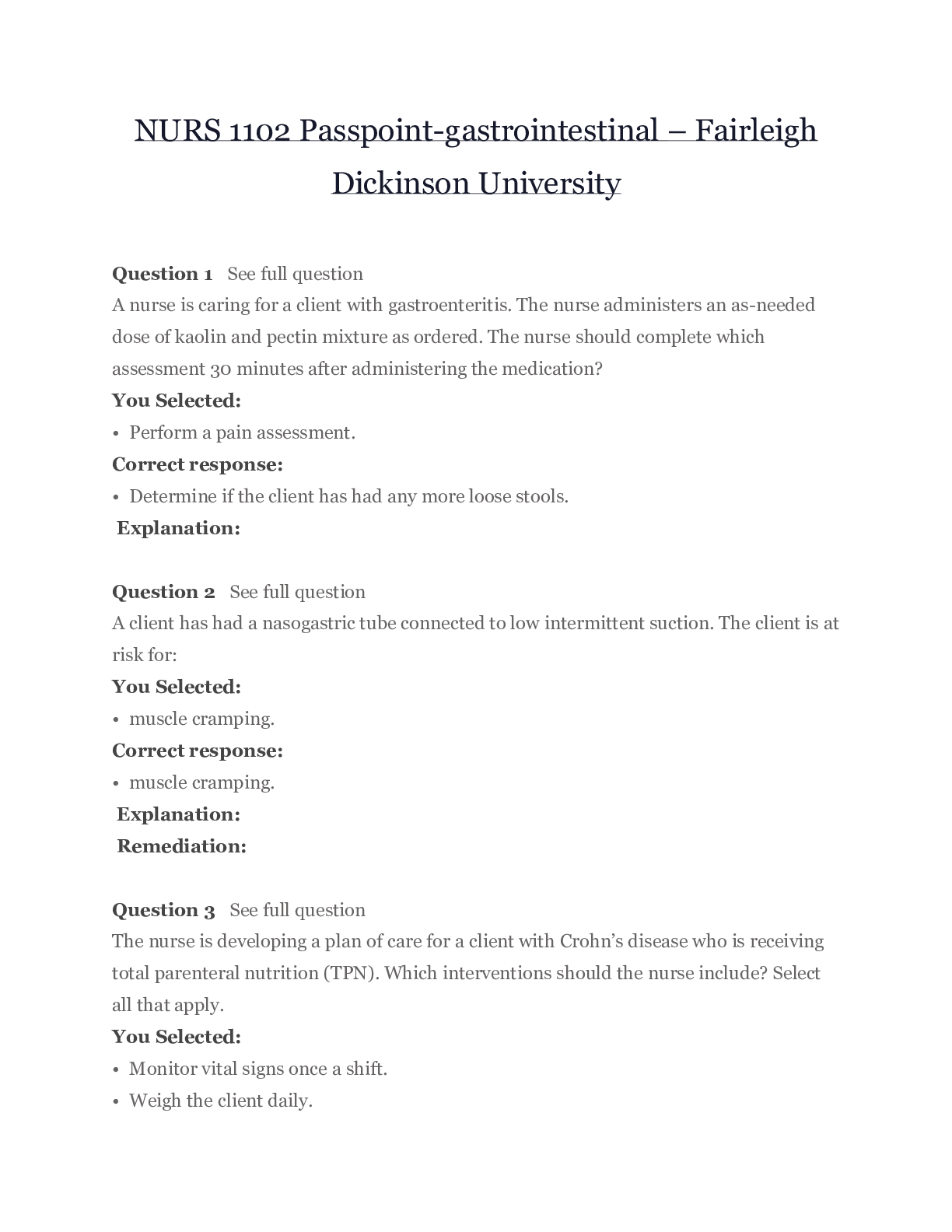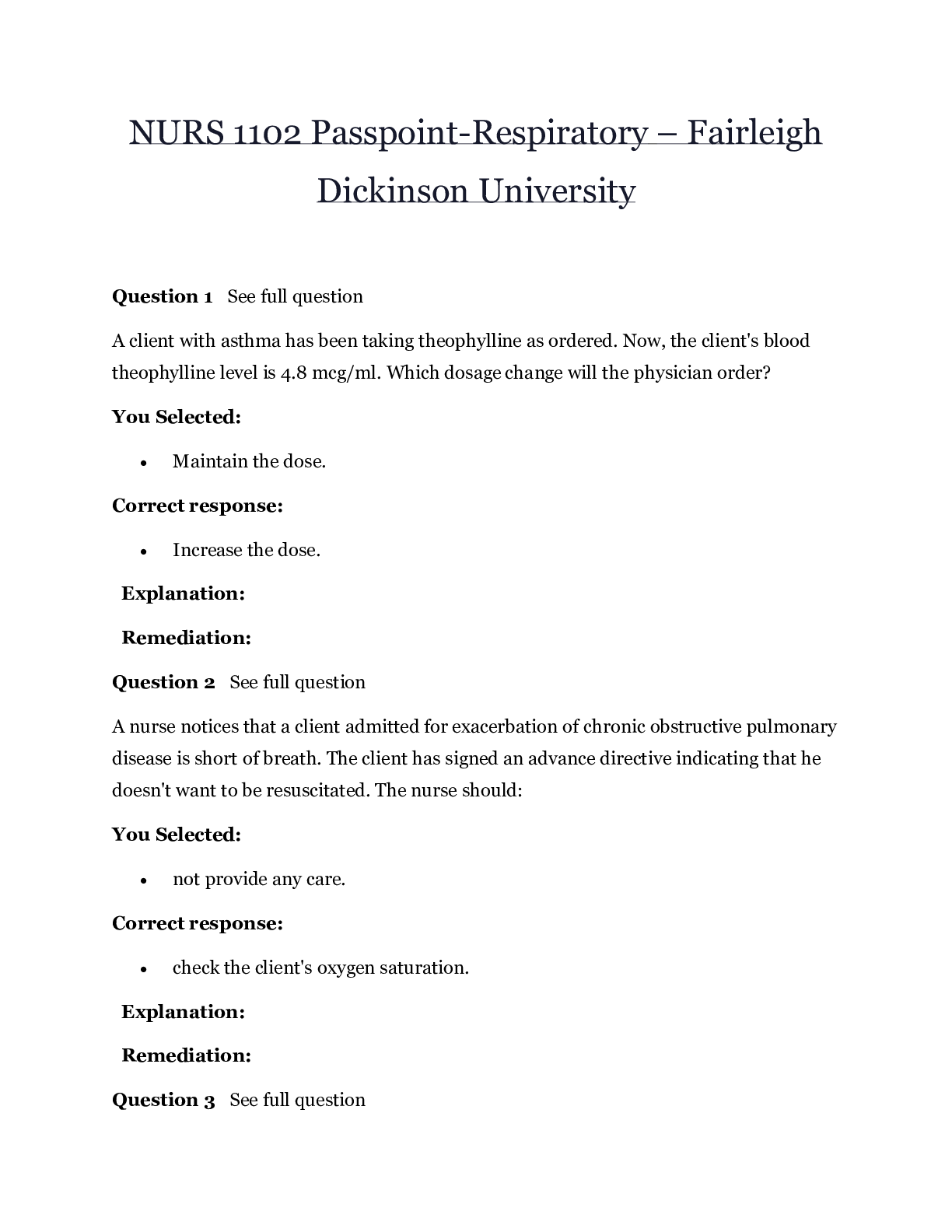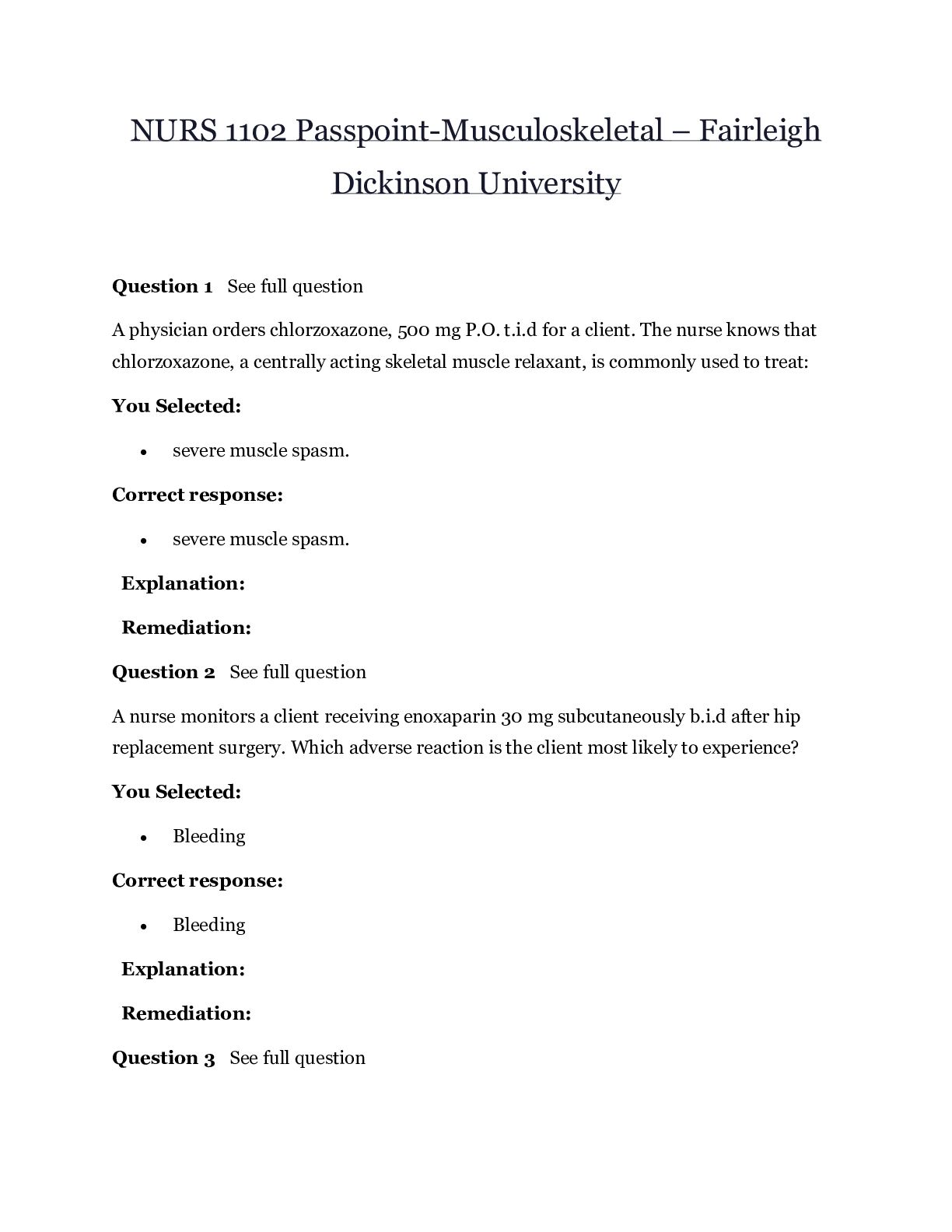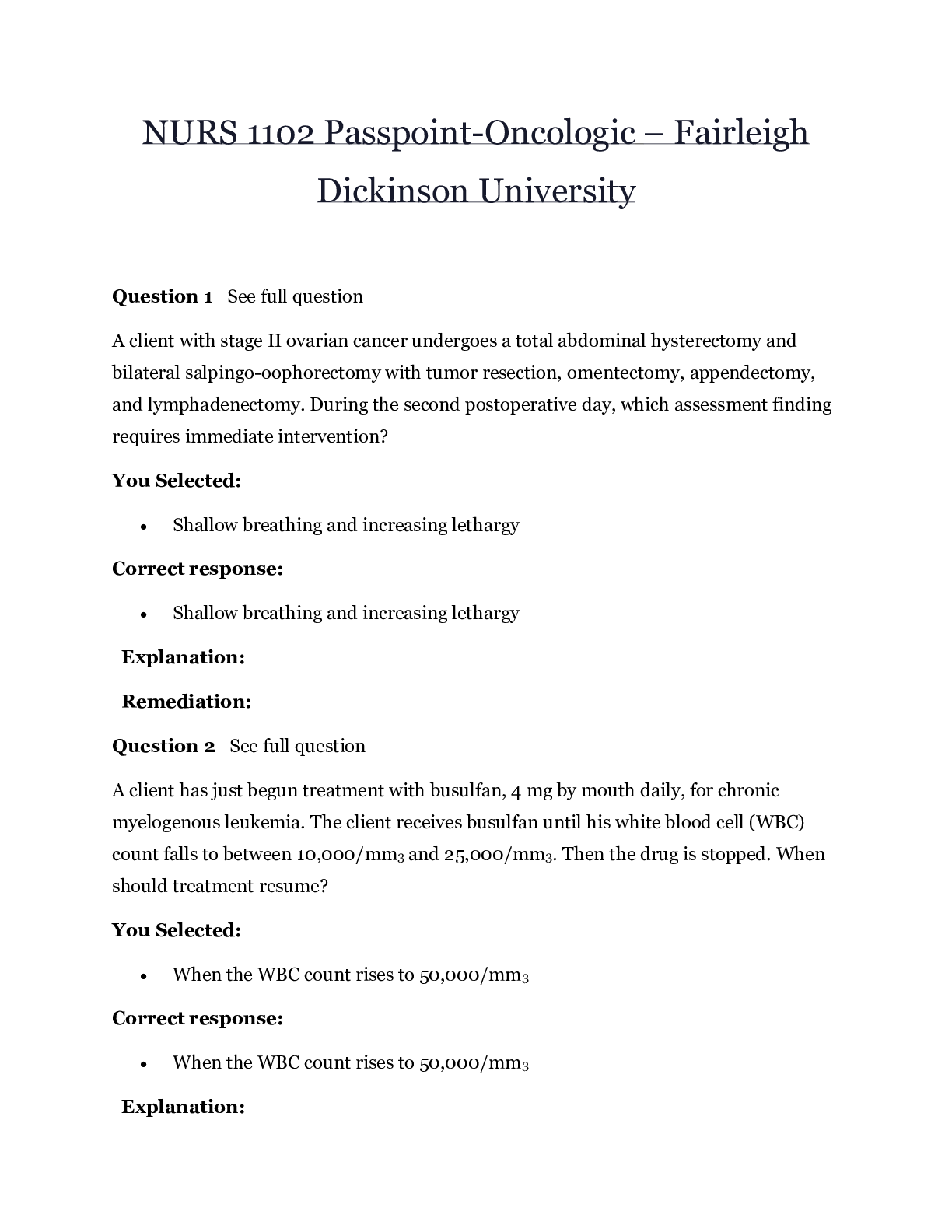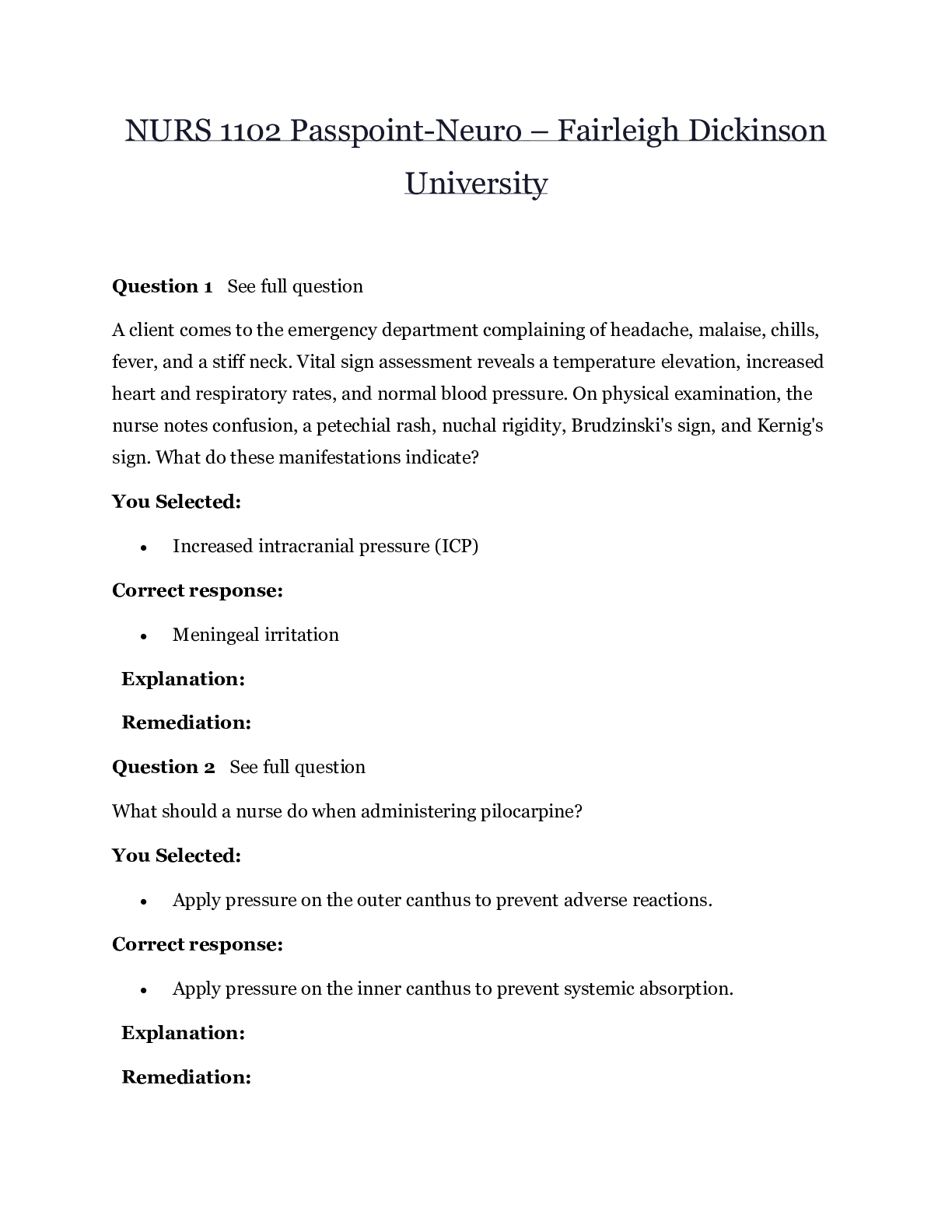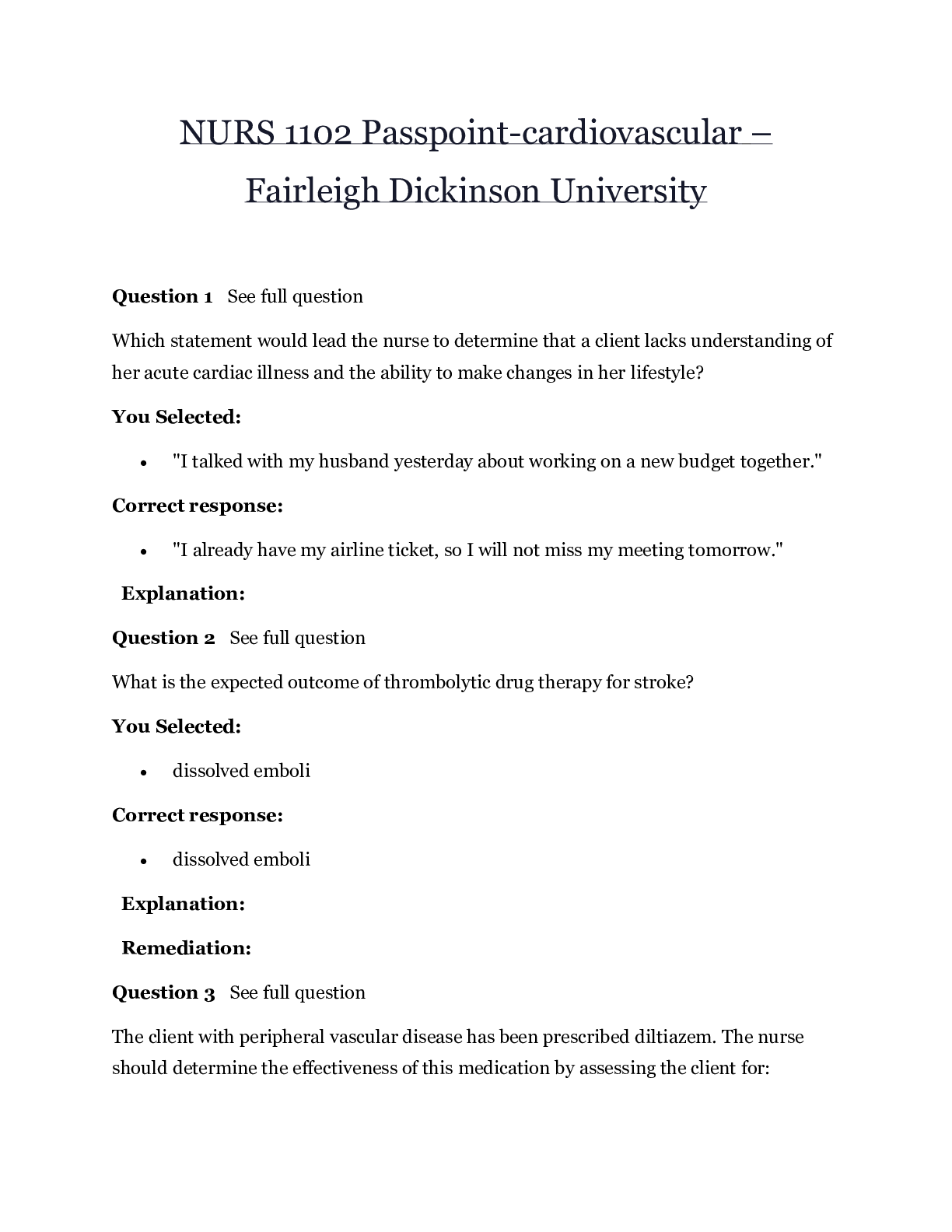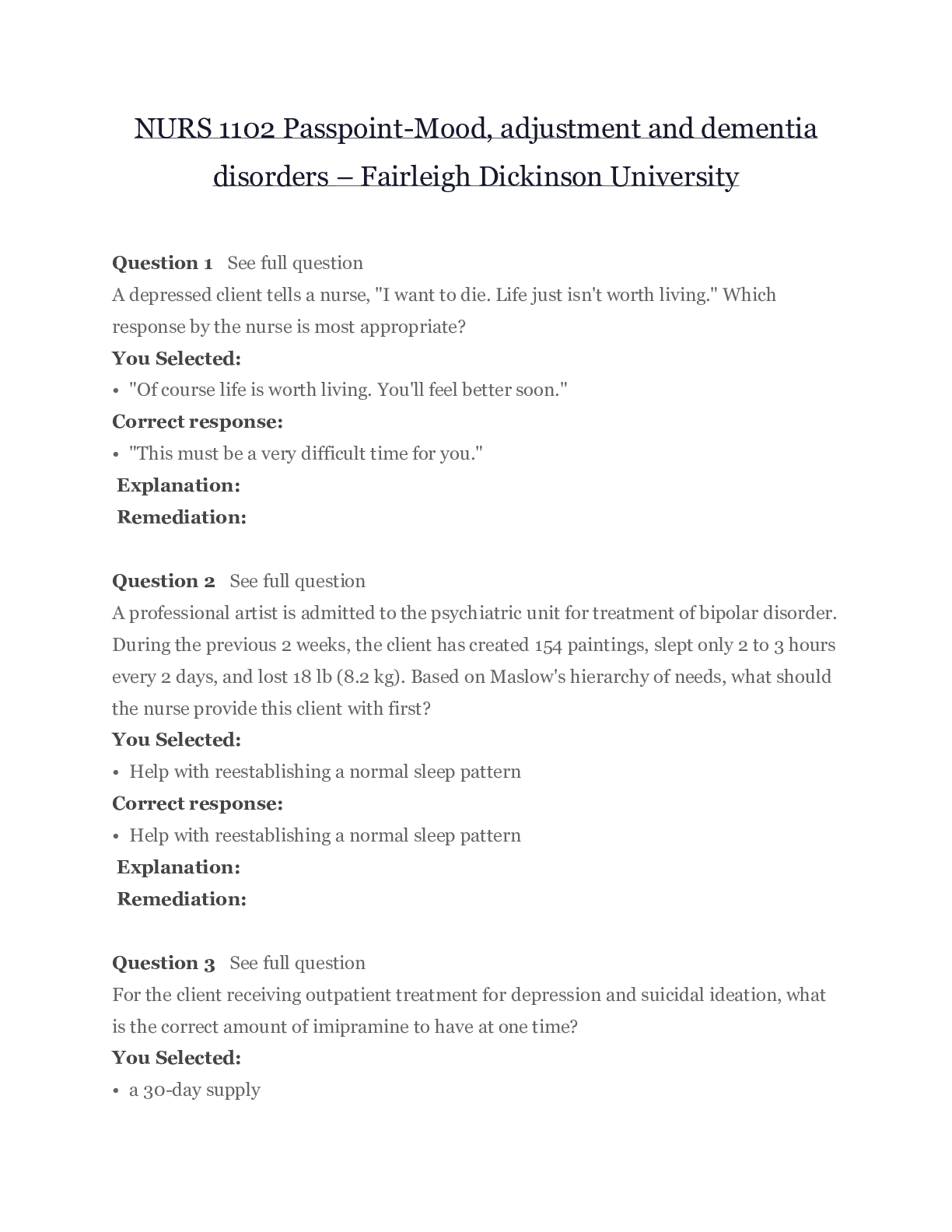*NURSING > EXAM > NURS 1102 Passpoint-Intrapartum – Fairleigh Dickinson University | NURS1102 Passpoint-Intrapartum (All)
NURS 1102 Passpoint-Intrapartum – Fairleigh Dickinson University | NURS1102 Passpoint-Intrapartum
Document Content and Description Below
NURS 1102 Passpoint-Intrapartum – Fairleigh Dickinson University Question 1 See full question A nurse is caring for a client with mild active bleeding from placenta previa. Which assessmen... t factor indicates that an emergency cesarean birth may be necessary? You Selected: • Maternal heart rate of 65 beats/minute Correct response: • Fetal heart rate of 80 beats/minute Explanation: Remediation: Question 2 See full question A client with hemolysis, elevated liver enzymes, and low platelet count (HELLP) syndrome is admitted to the labor and delivery unit. The client's condition rapidly deteriorates and despite efforts by the staff, the client dies. After the client's death, the nursing staff displays many emotions. With whom should the nurse-manager consult to help the staff cope with this unexpected death? You Selected: • The social worker, so she can contact the family about funeral arrangements and pass along the information to the nursing staff Correct response: • The chaplain, because his educational background includes strategies for handling grief Explanation: Remediation: Question 3 See full question A 31-year-old multigravid client at 39 weeks' gestation admitted to the hospital in active labor is receiving intravenous lactated Ringer's solution and a continuous epidural anesthetic. During the first hour after administration of the anesthetic, the nurse should monitor the client for: You Selected: • hypotension. Correct response: • hypotension. Explanation: Remediation: Question 4 See full question The nurse is caring for a multigravid client in active labor when the nurse detects variable fetal heart rate decelerations on the electronic monitor. The nurse interprets this as the compression of which structure? You Selected: • umbilical cord Correct response: • umbilical cord Explanation: Remediation: Question 5 See full question The membranes of a multigravid client in active labor rupture spontaneously, revealing greenish-colored amniotic fluid. How does the nurse interpret this finding? You Selected: • maternal intrauterine infection Correct response: • passage of meconium by the fetus Explanation: Remediation: Question 6 See full question Having had only one prenatal visit, a 16-year-old primigravida at 37 weeks’ gestation is admitted to the hospital in active labor. Her cervix is 7 cm dilated with the presenting part at +1 station. Soon after admission, the nurse observes that the client is hyperventilating. Which action would be mostappropriate? You Selected: • Give the client a paper bag and have her breathe into it. Correct response: • Give the client a paper bag and have her breathe into it. Explanation: Remediation: Question 7 See full question A client had a cesarean section with her first pregnancy and is hoping to have a vaginal birth with this pregnancy. She begins to cry at her 38-week visit when she realizes that her baby is a breech presentation. She says, “I just know it’s going to be horrible again. I won’t be able to breastfeed my baby. It will be painful.” Which of the following responses from the nurse is appropriate? You Selected: • “Tell me about your previous baby’s birth.” Correct response: • “Tell me about your previous baby’s birth.” Explanation: Remediation: Question 8 See full question The nurse is caring for a pregnant client. The nurse notes hypotension and a nonreassuring fetal heart tracing. Which of the following would the nurse include in the client’s plan of care? You Selected: • Call the healthcare provider Correct response: • Position the client on her left side Explanation: Remediation: Question 9 See full question A nurse is evaluating the external fetal monitoring strip (see image) of a client who is in labor. Which nursing interventions would the nurse implement? You Selected: • Reassure the client and continue to monitor the fetal heart rate. Correct response: • Reassure the client and continue to monitor the fetal heart rate. Explanation: Remediation: Question 10 See full question The nurse is performing Leopold’s maneuvers to determine fetal presentation and position. Which illustration shows the third maneuver? You Selected: • Correct response: • Explanation: Question 1 See full question Which physiologic change during labor makes it necessary for the nurse to assess blood pressure frequently? You Selected: • Alterations in cardiovascular function affect the fetus. Correct response: • Alterations in cardiovascular function affect the fetus. Explanation: Remediation: Question 2 See full question A nurse is caring for a client in labor. The external fetal monitor shows a pattern of variable decelerations in fetal heart rate. What should the nurse do first? You Selected: • Change the client's position. Correct response: • Change the client's position. Explanation: Remediation: Question 3 See full question While performing continuous electronic monitoring of a client in labor, the nurse should document which information about uterine contractions? You Selected: • Duration, frequency, and intensity Correct response: • Duration, frequency, and intensity Explanation: Remediation: Question 4 See full question What should the nurse include in the plan of care for a client with diabetes who is in labor? You Selected: • Administer insulin subcutaneously every 4 hours. Correct response: • Monitor blood glucose levels every hour. Explanation: Remediation: Question 5 See full question A laboring client on oxyitocin is becoming more vocal and is voicing increased pain with the uterine contractions. The nurse performs a fetal and maternal assessment and finds that the uterus is not relaxing between contractions. Based on the assessment findings, which of the following would be the best action for the nurse? You Selected: • Continue the oxytocin until uterine contractions are more frequent than every 2-3 minutes. Correct response: • Discontinue the oxytocin if the uterus does not relax between uterine contractions. Explanation: Remediation: Question 6 See full question A client of Asian descent has been laboring for 3 hours. The nurse notes that a laboring client’s temperature is elevated and her mucous membranes are becoming dry. The client has been refusing sips of water and ice that have been offered to her. Which is the most appropriate nursing action at this time? You Selected: • Ask the client what fluids she prefers to drink. Correct response: • Ask the client what fluids she prefers to drink. Explanation: Remediation: Question 7 See full question A couple arrives at the hospital stating that the client’s contractions started 3 hours ago. As they are walking into the room, the client tells the nurse that this is their fifth baby. What is the nurse’s first priority while performing the admission? You Selected: • Ensure that the client will have a support person in labor. Correct response: • Assess the imminence of birth. Explanation: Remediation: Question 8 See full question A 37-week gestation client is on bed rest for gestational hypertension. The nursing student and nurse are visiting the client in her home and need to perform external fetal monitoring (EFM). The student nurse asks the nurse if he/she is allowed to perform this skill. What is the nurse’s most appropriate response? You Selected: • "No, as per policy, you need to demonstrate this skill successfully in the hospital setting first." Correct response: • "Yes, but I will demonstrate it once and then supervise you while you perform the procedure." Explanation: Remediation: Question 9 See full question A nurse is caring for a multiparous client in the fourth stage of labor. Assessment reveals a boggy uterus. Which nursing intervention has the highest priority? You Selected: • Uterine massage Correct response: • Uterine massage Explanation: Remediation: Question 10 See full question The nurse who is assessing the position, presentation, and lie of the fetus of a 9-month-pregnant woman performs which of the following actions? You Selected: • Leopold's maneuvers Correct response: • Leopold's maneuvers Question 1 See full question A primigravid client is admitted to the labor and delivery area, where the nurse evaluates her. Which assessment finding may indicate the need for cesarean birth? You Selected: • Umbilical cord prolapse Correct response: • Umbilical cord prolapse Explanation: Remediation: Question 2 See full question A client in the fourth stage of labor asks to use the bathroom for the first time since giving birth. The client has oxytocin infusing. Which response by the nurse is best? You Selected: • "You may use the bathroom with my assistance." Correct response: • "You may use the bathroom with my assistance." Explanation: Remediation: Question 3 See full question A client who is in her third trimester presents at the labor and delivery triage area with a history of a fall. She has bruising on her back and arms. There is no vaginal bleeding and the fetal heart rate (FHR) shows accelerations. A completed Abuse Assessment Screen indicates the possibility of abuse. The nurse should refer this client to: You Selected: • the social worker on call. Correct response: • the social worker on call. Explanation: Remediation: Question 4 See full question The cervix of a 15-year-old primigravid client admitted to the labor area is 2 cm dilated and 50% effaced. Her membranes are intact, and contractions are occurring every 5 to 6 minutes. Which intervention should the nurse recommend at this time? You Selected: • lying in the left lateral recumbent position Correct response: • walking around in the hallway Explanation: Remediation: Question 5 See full question What would be the priority when caring for a primigravid client whose cervix is dilated at 8 cm when the fetus is at 1+ station and the client has had no analgesia or anesthesia? You Selected: • offering encouragement and support Correct response: • offering encouragement and support Explanation: Remediation: Question 6 See full question A 31-year-old client, G3, T0, P2, Ab0, L0 at 32 weeks’ gestation, is being admitted to the hospital with contractions of moderate intensity occurring every 3 to 4 minutes per the client report. The client is crying on admission; the history reveals that the client has previously had two nonviable fetuses at 30 weeks’ gestation. What nursing action would be the highest priority for this client? You Selected: • Assess maternal contraction and fetal heart rate pattern. Correct response: • Assess maternal contraction and fetal heart rate pattern. Explanation: Remediation: Question 7 See full question A multigravid client is admitted at 4-cm dilation and is requesting pain medication. The nurse gives the client nalbuphine 15 mg. Within five minutes, the client tells the nurse she feels like she needs to have a bowel movement. The nurse should first: You Selected: • complete a vaginal examination to determine dilation, effacement, and station. Correct response: • complete a vaginal examination to determine dilation, effacement, and station. Explanation: Remediation: Question 8 See full question The nurse is caring for a client in labor. The nurse notes variable decelerations on the fetal monitor strip. Which of the following interventions should the nurse include in the client’s plan of care? You Selected: • Calling the healthcare provider Correct response: • Repositioning the client on her side Explanation: Question 9 See full question The nurse is caring for a client in labor. Which of the following is how the nurse would report the frequency of each contraction? You Selected: • Measuring the length of time from the start of one contraction to the start of the next Correct response: • Measuring the length of time from the start of one contraction to the start of the next Explanation: Remediation: Question 10 See full question The nurse has provided an in-service presentation to ancillary staff about standard precautions on the birthing unit. The nurse determines that one of the staff members needs further instructions when the nurse observes which action? You Selected: • use of protective goggles during a caesarean birth Correct response: • wearing of sterile gloves to bathe a neonate at 2 hours of age Question 1 See full question A client at 36 weeks' gestation is admitted in preterm labor with a temperature of 101.2° F (38.4° C). She reports a steady dripping from the vaginal area and examination indicates that she's leaking amniotic fluid. A nurse realizes the probable cause of her fever is: You Selected: • a normal response to labor. Correct response: • intrauterine infection. Explanation: Remediation: Question 2 See full question A multigravid client is admitted to the labor area from the emergency room. At the time of admission, the fetal head is crowning, and the client yells, "The baby is coming!" To help the client remain calm and cooperative during the imminent birth, which response by the nurse is most appropriate? You Selected: • "I will explain what is happening to guide you as we go along." Correct response: • "I will explain what is happening to guide you as we go along." Explanation: Remediation: Question 3 See full question When preparing a multigravid client at 34 weeks’ gestation experiencing preterm labor for the shake test performed on amniotic fluid, the nurse would instruct the client that this test is done to evaluate the maturity of which fetal systems? You Selected: • urinary Correct response: • pulmonary Explanation: Remediation: Question 4 See full question The nurse is working with four clients on the obstetrical unit. Which client will be the highest priority for a cesarean section? You Selected: • client at 38 weeks' gestation with active herpes lesions Correct response: • client at 38 weeks' gestation with active herpes lesions Explanation: Remediation: Question 5 See full question A client with eclampsia begins to experience a seizure. Which intervention should the nurse do immediately? You Selected: • Maintain a patent airway. Correct response: • Maintain a patent airway. Explanation: Remediation: - - - - - - - - - - - - - - - - - - - - - - - - - - Question 6 See full question The primary care provider orders magnesium sulfate intravenously for a pregnant client with premature rupture of the membranes who begins to have contractions every 10 minutes. The drug has had expected effects when: You Selected: • contractions cease. Correct response: • contractions cease. Explanation: Remediation: Question 7 See full question The nurse is assisting in the birthing room. The physician performs an episiotomy, an incision in the client's perineum to enlarge the vaginal opening and facilitate childbirth. Which interventions should the nurse perform when caring for the client after this procedure? Select all that apply. You Selected: • Check the episiotomy repair site. • Change the dressings every shift. • Administer pain medication, as prescribed. Correct response: • Check the episiotomy repair site. • Apply ice to the perineum. • Administer pain medication, as prescribed. • Explain perineal care to the client when she can focus on the instructions. Explanation: Remediation: Question 8 See full question A client at 28 weeks’ gestation in premature labor was placed on nifedipine. To maintain the pregnancy, the primary health care provider orders the client to have 20 mg now, followed by 20 mg every 8 hours while contractions persist, not to exceed the maximum daily oral dose of 60 mg. At what time will the client have reached the maximum dose if she begins taking the medication at 0600? Record your answer using military time. Your Response: • 1400 Correct response: • 2200 Explanation: Remediation: Question 9 See full question A client in active labor asks the nurse why her blood pressure is being monitored so frequently. Which of the following is an appropriate response by the nurse? You Selected: • "Alterations in cardiovascular function affect the fetus." Correct response: • "Alterations in cardiovascular function affect the fetus." Explanation: Remediation: Question 10 See full question The nurse is preparing a laboring client for internal electronic fetal monitoring (EFM). Which finding requires nursing intervention? You Selected: • The membranes are intact. Correct response: • The membranes are intact. Question 1 See full question A nurse notices that a client in the first stage of labor seems agitated. When the nurse asks why she's upset, she begins to cry and says, "I guess I'm a little worried. The last time I gave birth, I was in labor for 32 hours." Based on this information, the nurse should include which nursing diagnosis in the client's care plan? You Selected: • Compromised family coping related to hospitalization Correct response: • Fear related to a potentially difficult childbirth Explanation: Remediation: Question 2 See full question In the first stage of labor, a client with a full-term pregnancy has external electronic fetal monitoring (EFM) in place. Which EFM pattern suggests adequate uteroplacental-fetal perfusion? You Selected: • Late decelerations Correct response: • Fetal heart rate accelerations Explanation: Remediation: Question 3 See full question A 39-year-old multigravid client at 39 weeks' gestation admitted to the hospital in active labor has been diagnosed with class II heart disease. To ensure cardiac emptying and adequate oxygenation during labor, the nurse plans to encourage the client to: You Selected: • remain in a side-lying position with the head elevated. Correct response: • remain in a side-lying position with the head elevated. Explanation: Remediation: Question 4 See full question What should be the nurse’s priority assessment after an epidural anesthetic has been given to a nulligravid client in active labor? You Selected: • blood pressure Correct response: • blood pressure Explanation: Remediation: Question 5 See full question Two hours ago, examination of a multigravid client in labor without anesthesia revealed the following: cervical dilation at 5 cm with complete effacement, presenting part at 0 station, and membranes intact. The nurse caring for the client now observes that the client is irritable and has had some nausea with one episode of vomiting. The client is most likely experiencing: You Selected: • transition phase of labor. Correct response: • transition phase of labor. Explanation: Remediation: Question 6 See full question A client with class II cardiac disease in active labor is planning on epidural anesthesia for labor and birth. After the anesthesiologist has explained the procedure and potential complications, the nurse determines that the client needs further instructions when she says: You Selected: • “I may need to lie flat for 6 hours and drink plenty of fluids after I give birth." Correct response: • “I may need to lie flat for 6 hours and drink plenty of fluids after I give birth." Explanation: Remediation: Question 7 See full question A multigravida in active labor is 7 cm dilated. The fetal heart rate baseline is 130 bpm with moderate variability. The client begins to have variable decelerations to 100 to 110 bpm. What should the nurse do next? You Selected: • Reposition the client and continue to evaluate the tracing. Correct response: • Reposition the client and continue to evaluate the tracing. Explanation: Remediation: Question 8 See full question The nurse observes late decelerations on the fetal heart tracing of a woman in labor. Which interventions are most appropriate for the nurse to take to correct this situation? Select all that apply. You Selected: • Oxygen administration • Maternal position change • IV hydration Correct response: • IV hydration • Maternal position change • Oxygen administration Explanation: Remediation: Question 9 See full question A multiparous client at 33 weeks gestation is admitted to the labor and birth area with painless vaginal bleeding. Ultrasonography shows marginal placenta previa. Which nursing interventions should be included in the plan of care for this client? Select all that apply. You Selected: • Institute bed rest • Administer oxygen as ordered • Apply continuous fetal heart monitoring Correct response: • Institute bed rest • Establish intravenous (IV) access • Apply continuous fetal heart monitoring • Administer oxygen as ordered Explanation: Remediation: Question 10 See full question The nurse is caring for a client that has been in labor for 6 hours. When does the nurse document that the client has ended the third stage of labor? You Selected: • When the neonate has been born Correct response: • When the placenta has been birthed Question 1 See full question Which fetal presentation is most favorable for birth? You Selected: • Posterior position of the fetal head Correct response: • Vertex presentation Explanation: Remediation: Question 2 See full question Due to a prolonged stage II of labor, the client is being prepared for an instrument-assisted birth. What information related to the mother and neonate's care must the nurse consider? You Selected: • Clients having instrument- assisted births are more likely to have postpartum hemorrhage. Correct response: • A vacuum extractor is safer than forceps because it causes less trauma to the neonate and the mother's perineum. Explanation: Remediation: Question 3 See full question A pregnant client’s labor is progressing, but her cervix is still only 5 cm dilated and 100% effaced. Although she appears relaxed, she is aware of labor contractions. At this time, which suggestion would be most helpful for the client’s partner? You Selected: • “Keep a record of her contraction pattern." Correct response: • “Encourage her to rest between contractions." Explanation: Remediation: Question 4 See full question While the nurse is caring for a multiparous client in active labor at 36 weeks' gestation, the client tells the nurse, "I think my water just broke." What should the nurse do first? You Selected: • Assess the fetal heart rate pattern. Correct response: • Assess the fetal heart rate pattern. Explanation: Remediation: Question 5 See full question A term primigravida was involved in a car accident 3 hours ago. She is having labor contractions every 4 minutes, and her cervical exam is dilated 3cm, 100% effaced and station -1. She is crying uncontrollably and states her pain is constant and severe, rating it at 10/10. The priority action by the nurse is to: You Selected: • assess the intensity of contractions and determine if she would like an epidural. Correct response: • notify the provider of the pain and request an assessment for potential abruption. Explanation: Remediation: Question 6 See full question The nurse is assessing fetal presentation in a multiparous client. The illustration indicates which type of presentation? You Selected: • frank breech Correct response: • frank breech Explanation: Remediation: Question 7 See full question A client at 28 weeks’ gestation in premature labor was placed on nifedipine. To maintain the pregnancy, the primary health care provider orders the client to have 20 mg now, followed by 20 mg every 8 hours while contractions persist, not to exceed the maximum daily oral dose of 60 mg. At what time will the client have reached the maximum dose if she begins taking the medication at 0600? Record your answer using military time. Your Response: • 2200 Correct response: • 2200 Explanation: Remediation: Question 8 See full question The nurse performs the initial assessment and reports the following findings to the physician: The client’s contractions started 5 hours ago and are now coming every 3 minutes and lasting for 60 seconds. The cervix is 100% effaced and 5 cm dilated, the membranes are intact, and the presenting part is well applied to the cervix and is at -1 station. The nurse recognizes that the client is in which stage of labor? You Selected: • Active Correct response: • Active Explanation: Remediation: Question 9 See full question A client who has abruptio placentae exhibits cyanosis in her earlobes, capillary filling time >3 seconds, and reports “heartburn.” Which of the following is the best nursing intervention? You Selected: • Elevate the head of the bed. Correct response: • Notify the healthcare provider immediately. Explanation: Remediation: Question 10 See full question The nurse is assisting with the birth of a fetus in a frank breech presentation. Which graphic illustrates that position? You Selected: • Correct response: • Explanation: Question 1 See full question A woman in labor shouts to the nurse, "My baby is coming right now! I feel like I have to push!" An immediate nursing assessment reveals that the head of the fetus is crowning. After asking another staff member to notify the physician and setting up for birth, which nursing intervention is most appropriate? You Selected: • Applying gentle pressure to the baby's head Correct response: • Applying gentle pressure to the baby's head Explanation: Remediation: Question 2 See full question At 6 cm dilation, a client in labor receives a lumbar epidural for pain control. Which nursing diagnosis is most appropriate? You Selected: • Altered tissue perfusion related to effects of anesthesia Correct response: • Altered tissue perfusion related to effects of anesthesia Explanation: Remediation: Question 3 See full question Following an epidural and placement of internal monitors, a client's labor is augmented. Contractions are lasting greater than 90 seconds and occurring every 1½ minutes. The uterine resting tone is greater than 20 mm Hg with an atypical fetal heart rate and pattern. Which action should the nurse take first? You Selected: • Turn off the oxytocin infusion. Correct response: • Turn off the oxytocin infusion. Explanation: Remediation: Question 4 See full question A client is admitted in early active labor at 39 weeks’ gestation with intact membranes. When assessing the fetal heart rate, the nurse locates the heart sounds above the client’s umbilicus at midline. The nurse should further confirm that the fetus is lying in which position? You Selected: • cephalic Correct response: • frank breech Explanation: Remediation: Question 5 See full question A client with eclampsia begins to experience a seizure. Which intervention should the nurse do immediately? You Selected: • Maintain a patent airway. Correct response: • Maintain a patent airway. Explanation: Remediation: Question 6 See full question A client whose cervix is 10 cm dilated begins to push. The nurse notes early decelerations of the fetal heart rate. The nurse should interpret this finding as being caused by which factor? You Selected: • fetal head compression Correct response: • fetal head compression Explanation: Remediation: Question 7 See full question The nurse is caring for a multigravida in active labor with continuous electronic fetal heart rate monitoring. As the client begins to push, the nurse observes that the fetal heart rate shows a deceleration pattern that mirrors the contractions. The nurse should: You Selected: • continue to monitor the client and fetus. Correct response: • continue to monitor the client and fetus. Explanation: Remediation: Question 8 See full question A laboring client at –2 station has a spontaneous rupture of the membranes, and a cord immediately protrudes from the vagina. The nurse should first: You Selected: • place gentle pressure upward on the fetal head. Correct response: • place gentle pressure upward on the fetal head. Explanation: Remediation: Question 9 See full question A nurse is caring for a woman G1 P0 at 40 weeks gestation in active labor. Assessments include: cervix 5 cm dilated; 90% effaced; station 0; cephalic presentation; FHR baseline is 135 bpm and decreases to 125 bpm shortly after onset of 5 uterine contractions and returns to baseline before the uterine contraction ends. Based on this assessment, what action should the nurse take first? You Selected: • Perform vaginal exam to rule out umbilical cord prolapse. Correct response: • Document findings on the client’s chart, and continue to monitor labor progress. Explanation: Remediation: Question 2 See full question A client in the early stages of labor is admitted to the labor and delivery unit. During the admission assessment, the client fails to make eye contact with the nurse. The nurse notes ecchymotic areas on the client's thighs and forearms. The partner is present at the client's bedside. The nurse suspects domestic abuse, how should she respond? You Selected: • When the partner leaves the room, ask the client if she ever feels unsafe at home. Correct response: • When the partner leaves the room, ask the client if she ever feels unsafe at home. Explanation: Remediation: Question 3 See full question A primigravida is admitted to the labor area with ruptured membranes and contractions occurring every 2 to 3 minutes, lasting 45 seconds. After 3 hours of labor, the client's contractions are now every 7 to 10 minutes, lasting 30 seconds. The nurse administers oxytocin as prescribed. The expected outcome of this drug is: You Selected: • contractions will occur every 2 to 3 minutes, lasting 40-60 seconds, moderate intensity, resting tone between contractions. Correct response: • contractions will occur every 2 to 3 minutes, lasting 40-60 seconds, moderate intensity, resting tone between contractions. Explanation: Remediation: Question 4 See full question The membranes of a multigravid client in active labor rupture spontaneously, revealing greenish-colored amniotic fluid. How does the nurse interpret this finding? You Selected: • passage of meconium by the fetus Correct response: • passage of meconium by the fetus Explanation: Remediation: Question 5 See full question A client who is positive for human immunodeficiency virus (HIV) tells the nurse that her significant other is the only family member who knows her health status. What should the nurse do to keep the client's health status confidential? Select all that apply. You Selected: • Use the hospital code for HIV when documenting care. • Ask all family members, except the client's significant other, to wait outside when she's educating the client. Correct response: • Use the hospital code for HIV when documenting care. • Ask all family members, except the client's significant other, to wait outside when she's educating the client. Explanation: Question 6 See full question A laboring client with preeclampsia is prescribed magnesium sulfate 2 g/h IV piggyback. The pharmacy sends the IV to the unit labeled magnesium sulfate 20 g/500 ml normal saline. To deliver the correct dose, the nurse should set the pump to deliver how many milliliters per hour? Record your answer using a whole number. Your Response: • 50 Correct response: • 50 Explanation: Remediation: Question 7 See full question A multigravida with a history of cesarean birth due to fetal distress is admitted for a trial labor and possible vaginal birth. After several hours of active labor, the primary care provider prescribes nalbuphine. The nurse evaluates the drug as effective when the client makes which statement? You Selected: • “I do not feel the nausea like I did the last time." Correct response: • "The contractions do not seem as painful as before.” Explanation: Question 8 See full question The nurse is caring for a laboring client fluent in English, but the client defers to her mother-in-law when asked to sign the hospital consent forms. Which of the following factors contributes to the challenges the nurse faces in obtaining consent? You Selected: • Patterns of verbal communication Correct response: • Influence of the extended family Explanation: Remediation: Question 9 See full question A woman who delivered her last infant by caesarean section is admitted to the hospital at term with contractions every 5 minutes. The health care provider (HCP) intends to have her undergo “a trial labor.” The nurse explains to the client that: You Selected: • labor progress will be evaluated continually to determine appropriate progress for a vaginal delivery. Correct response: • labor progress will be evaluated continually to determine appropriate progress for a vaginal delivery. Explanation: Question 10 See full question A nurse is caring for a woman G1 P0 at 40 weeks gestation in active labor. Assessments include: cervix 5 cm dilated; 90% effaced; station 0; cephalic presentation; FHR baseline is 135 bpm and decreases to 125 bpm shortly after onset of 5 uterine contractions and returns to baseline before the uterine contraction ends. Based on this assessment, what action should the nurse take first? You Selected: • Document findings on the client’s chart, and continue to monitor labor progress. Correct response: • Document findings on the client’s chart, and continue to monitor labor progress. Explanation: Remediation: /.modal - - - - - - - - - - - - - - - - - - - - - - - - Footer - - - - - - - - - - - - - - - - - - - - - - - - - Question 10 See full question Which client is the best candidate for a vaginal birth after a caesarean (VBAC)? You Selected: • client who had an emergency caesarean section because of fetal distress during her last delivery and has a classic incision Correct response: • client who had a breech presentation in her last pregnancy, and this pregnancy is a vertex pregnancy Question 1 See full question The client with preeclampsia asks the nurse why she is receiving magnesium sulfate. The nurse's most appropriate response to is to tell the client that the priority reason for giving her magnesium sulfate is to: You Selected: • prevent seizures. Correct response: • prevent seizures. Explanation: Remediation: Question 2 See full question The nurse is explaining the medication options available for pain relief during labor. The nurse realizes the client needs further teaching when the client makes which statement? You Selected: • "I can have an epidural as soon as I start contracting." Correct response: • "I can have an epidural as soon as I start contracting." Explanation: Remediation: Question 3 See full question A client is induced with oxytocin. The fetal heart rate is showing accelerations lasting 15 seconds and exceeding the baseline with fetal movement. What action associated with this finding should the nurse take? You Selected: • Document fetal well-being. Correct response: • Document fetal well-being. Explanation: Remediation: Question 4 See full question The health care provider (HCP) has determined that a preterm labor client at 34 weeks' gestation has no fetal fibronectin present. Based on this finding, the nurse would anticipate that within the next week: You Selected: • the client will not develop preterm labor. Correct response: • the client will not develop preterm labor. Explanation: Remediation: Question 5 See full question While caring for a multigravid client in early labor in a birthing center, which food would be best if the client requests a snack? You Selected: • vegetable soup Correct response: • yogurt Explanation: Remediation: Question 6 See full question The nurse is caring for a G2, T1, P0, A0, L1 client at term. The client is completely effaced, dilated to 2 cm, with contractions every 3 minutes lasting 45 seconds. The client is asking for an epidural to make her more comfortable. Indicate the appropriate response by the nurse. You Selected: • “It is too early in labor for the epidural, but you can have IV medication to keep you comfortable until you have dilated 1 to 2 cm more.” Correct response: • “It is too early in labor for the epidural, but you can have IV medication to keep you comfortable until you have dilated 1 to 2 cm more.” Explanation: Remediation: Question 7 See full question The nurse instructs the client about the procedures that will be performed on the neonate immediately after birth to prevent meconium aspiration. The nurse determines that the instructions have been effective when the client states that which procedure will be done to her baby? You Selected: • “The baby will be given a drug to dilate the bronchi." Correct response: • "Suctioning will be needed if the baby is floppy." Explanation: Remediation: Question 8 See full question The nurse is teaching a G2P1 client about her upcoming labor. Which of the following responses would indicate to the nurse that further teaching is necessary? You Selected: • “I can wait until my contractions are every 2 minutes to contact the physician because my first labor was so long.” Correct response: • “I can wait until my contractions are every 2 minutes to contact the physician because my first labor was so long.” Explanation: Remediation: Question 9 See full question The nurse is performing a vaginal examination on a client in labor. The nurse finds the fetal presenting part 1 cm above the ischial spines. The nurse should chart the station as: You Selected: • -1 station. Correct response: • -1 station. Explanation: Remediation: Question 10 See full question The nurse is managing a pregnant client’s second stage of labor. The nurse should intervene when observing which action? You Selected: • closed glottis pushing Correct response: • closed glottis pushing [Show More]
Last updated: 1 year ago
Preview 1 out of 97 pages
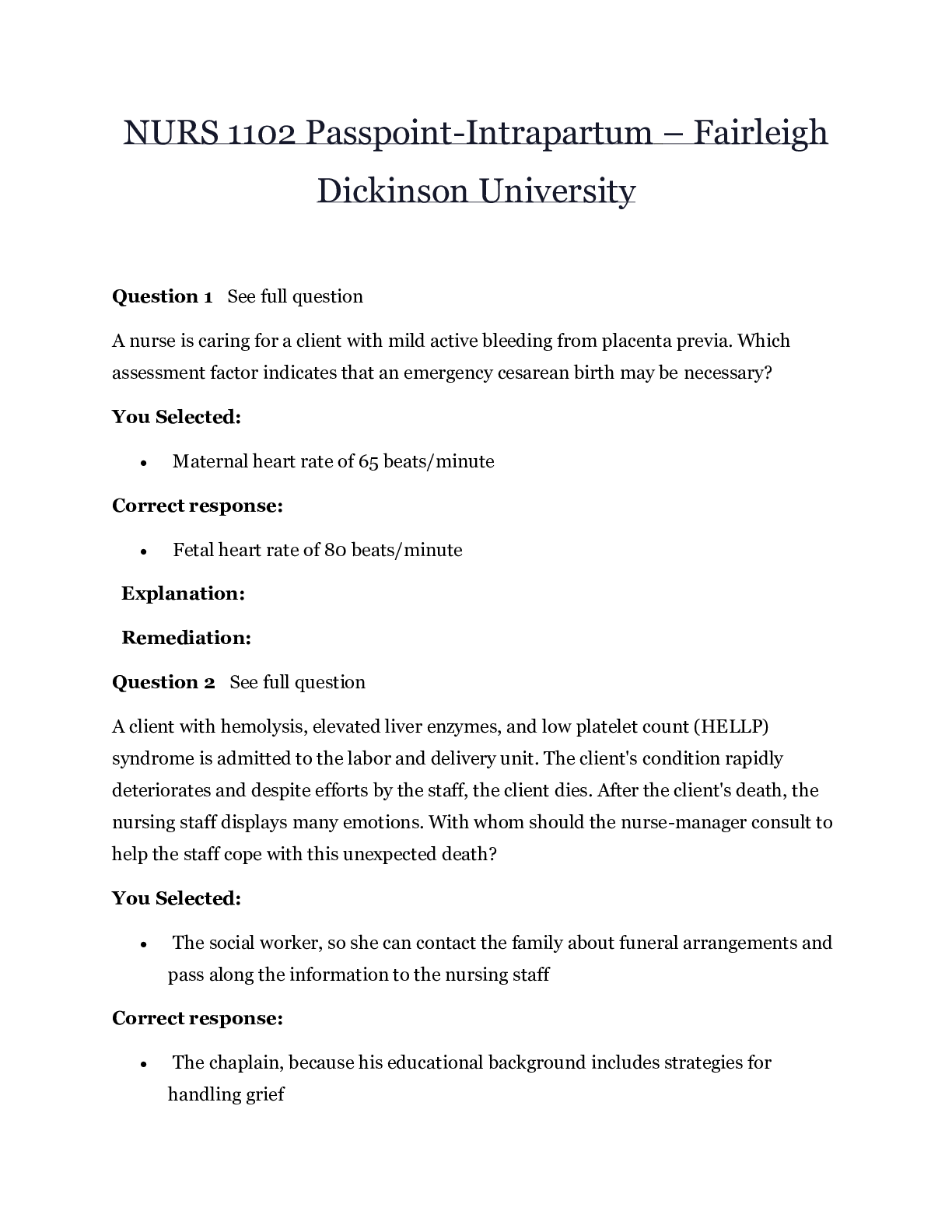
Buy this document to get the full access instantly
Instant Download Access after purchase
Add to cartInstant download
We Accept:

Reviews( 0 )
$16.50
Document information
Connected school, study & course
About the document
Uploaded On
Aug 15, 2020
Number of pages
97
Written in
Additional information
This document has been written for:
Uploaded
Aug 15, 2020
Downloads
0
Views
86















